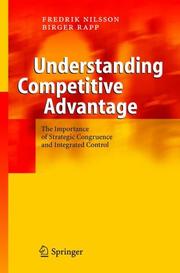| Listing 1 - 7 of 7 |
Sort by
|
Book
ISBN: 9780470709115 0470709111 Year: 1974 Publisher: Stockholm: Almqvist och Wiksell,
Abstract | Keywords | Export | Availability | Bookmark
 Loading...
Loading...Choose an application
- Reference Manager
- EndNote
- RefWorks (Direct export to RefWorks)

ISBN: 1280235063 9786610235063 3540266992 354040872X 3642074138 Year: 2005 Publisher: Berlin : Springer-Verlag,
Abstract | Keywords | Export | Availability | Bookmark
 Loading...
Loading...Choose an application
- Reference Manager
- EndNote
- RefWorks (Direct export to RefWorks)
This book is about competitive advantage and how it is created at the company level. It is based on the premise that the alignment of strategies and control systems affects the firm's chances of successfully positioning itself in its chosen arena of competition.
Competition. --- Industrial management. --- Business administration --- Business enterprises --- Business management --- Corporate management --- Corporations --- Industrial administration --- Management, Industrial --- Rationalization of industry --- Scientific management --- Management --- Business --- Industrial organization --- Competition --- Competition (Economics) --- Competitiveness (Economics) --- Economic competition --- Commerce --- Conglomerate corporations --- Covenants not to compete --- Industrial concentration --- Monopolies --- Open price system --- Supply and demand --- Trusts, Industrial --- Economic aspects --- Organization. --- Organisation --- Planning. --- Creation (Literary, artistic, etc.) --- Executive ability --- Organization

Abstract | Keywords | Export | Availability | Bookmark
 Loading...
Loading...Choose an application
- Reference Manager
- EndNote
- RefWorks (Direct export to RefWorks)
Electronic commerce --- Industrial management --- Industrial organization --- Information technology --- Work --- 338.020 --- 338.043 --- 384.7 --- 658.0 --- AA / International- internationaal --- Industry (Psychology) --- Method of work --- Work, Method of --- Human behavior --- Labor --- Occupations --- Work-life balance --- Forecasting --- Theorie van de arbeid --- Technologische vooruitgang. Automatisering. Computers. Werkgelegenheid en informatica --- Tele-informatie. Datatransmissie --- Organisatie van de ondernemingen. Bedrijfsplan. Algemeenheden --- Organization theory --- Computer. Automation
Multi
ISBN: 9783540266990 Year: 2005 Publisher: Berlin, Heidelberg Springer Berlin · Heidelberg
Abstract | Keywords | Export | Availability | Bookmark
 Loading...
Loading...Choose an application
- Reference Manager
- EndNote
- RefWorks (Direct export to RefWorks)
The link between strategies and control systems and how it ultimately af fects the competitiveness of firms is an area that is attracting the atten tion of practitioners and scholars. There is a need to discuss which combi nations of strategies and control systems can be assumed to contribute to competitive strength. In this book we have chosen to highlight the role of management control and manufacturing control in this respect. For a long time these two types of control systems were regarded as more or less separate subjects of research and study. However, the differences between management control and manufacturing control are diminishing, a ten dency that we support. The book is written in this spirit of approval. The models and hypotheses advanced in the book were developed over a long period of time. They are based on research and have been published and otherwise presented in a variety of different circumstances (see, for example, Jansson et al., 2000; Kald et al., 2000; Nilsson, 1994, 1997, 2002; Rapp et al., 2000). Our colleagues have stimulated our thinking and have contributed to further refinement of the thoughts presented in the book. We would like to thank Professor Leif Appelgren, Professor Thomas Falk, Professor Nils Goran Olve, Professor Rolf Rundfelt, Professor Bengt Saven, Associate professor Vivian Vimarlund and Assistant professor Alf Westelius for their valuable comments and inspiration.
Production management --- bedrijfsplanning --- bedrijfsorganisatie
Book
ISBN: 3642391338 3642391346 Year: 2014 Publisher: Berlin, Heidelberg : Springer Berlin Heidelberg : Imprint: Springer,
Abstract | Keywords | Export | Availability | Bookmark
 Loading...
Loading...Choose an application
- Reference Manager
- EndNote
- RefWorks (Direct export to RefWorks)
How should firms’ control systems be designed and used to formulate and implement strategies that will contribute to competitive advantage and sustained high performance? This book offers some thought-provoking suggestions. It contains empirical studies of such diverse manufacturing enterprises as Atlas Copco, Electrolux, Saab, Scania, SCA Packing and Volvo, as well as an insurance company and two chamber orchestras. All firms and organizations presented offer interesting and exciting insights, each in a specific way and each with a fascinating history. The book presents research on the relationship between strategy, control and competitive advantage over extended periods and at several strategic levels, while also taking into account the existence of multiple control systems in a single firm or other organization. Readers are offered an in-depth look into how changes in the environment lead to adjustments in strategies and control systems. It is shown, in addition, how difficult and challenging it can be to implement these changes, and why such efforts are not always successful. But perhaps most importantly, the book conveys an in-depth understanding of how strategies and control systems affect competitive advantage and performance. In both its coverage and focus, the book is unique. Not only does it provide valuable contributions to the research field of strategy and management control; it also represents a substantial commitment in terms of resources and involvement over an extended period. The book is highly recommended to researchers, practitioners, graduate students and all others interested in this area.
Business planning. --- Decision making. --- Strategic planning. --- Strategy. --- Success. --- Growth (Psychology) --- Personal development --- Personal growth --- Self-improvement --- Military strategy --- Goal setting (Strategic planning) --- Planning, Strategic --- Strategic intent (Strategic planning) --- Strategic management --- Deciding --- Decision (Psychology) --- Decision analysis --- Decision processes --- Making decisions --- Management --- Management decisions --- Business enterprises --- Business plans --- Corporate planning --- Corporate strategy --- Corporations --- Strategy, Corporate --- Decision making --- Planning --- Business. --- Management. --- Leadership. --- Organization. --- Planning. --- Business and Management. --- Business Strategy/Leadership. --- Conduct of life --- Fortune --- Failure (Psychology) --- Fear of success --- Military art and science --- Military doctrine --- Business planning --- Choice (Psychology) --- Problem solving --- Strategic planning --- Organisation --- Administration --- Industrial relations --- Organization --- Ability --- Command of troops --- Followership --- Creation (Literary, artistic, etc.) --- Executive ability
Book
ISBN: 9783540266990 Year: 2005 Publisher: Berlin Heidelberg Springer Berlin Heidelberg
Abstract | Keywords | Export | Availability | Bookmark
 Loading...
Loading...Choose an application
- Reference Manager
- EndNote
- RefWorks (Direct export to RefWorks)
The link between strategies and control systems and how it ultimately af fects the competitiveness of firms is an area that is attracting the atten tion of practitioners and scholars. There is a need to discuss which combi nations of strategies and control systems can be assumed to contribute to competitive strength. In this book we have chosen to highlight the role of management control and manufacturing control in this respect. For a long time these two types of control systems were regarded as more or less separate subjects of research and study. However, the differences between management control and manufacturing control are diminishing, a ten dency that we support. The book is written in this spirit of approval. The models and hypotheses advanced in the book were developed over a long period of time. They are based on research and have been published and otherwise presented in a variety of different circumstances (see, for example, Jansson et al., 2000; Kald et al., 2000; Nilsson, 1994, 1997, 2002; Rapp et al., 2000). Our colleagues have stimulated our thinking and have contributed to further refinement of the thoughts presented in the book. We would like to thank Professor Leif Appelgren, Professor Thomas Falk, Professor Nils Goran Olve, Professor Rolf Rundfelt, Professor Bengt Saven, Associate professor Vivian Vimarlund and Assistant professor Alf Westelius for their valuable comments and inspiration.
Production management --- bedrijfsplanning --- bedrijfsorganisatie
Digital
ISBN: 9783642391347 Year: 2014 Publisher: Berlin, Heidelberg Springer
Abstract | Keywords | Export | Availability | Bookmark
 Loading...
Loading...Choose an application
- Reference Manager
- EndNote
- RefWorks (Direct export to RefWorks)
How should firms’ control systems be designed and used to formulate and implement strategies that will contribute to competitive advantage and sustained high performance? This book offers some thought-provoking suggestions. It contains empirical studies of such diverse manufacturing enterprises as Atlas Copco, Electrolux, Saab, Scania, SCA Packing and Volvo, as well as an insurance company and two chamber orchestras. All firms and organizations presented offer interesting and exciting insights, each in a specific way and each with a fascinating history. The book presents research on the relationship between strategy, control and competitive advantage over extended periods and at several strategic levels, while also taking into account the existence of multiple control systems in a single firm or other organization. Readers are offered an in-depth look into how changes in the environment lead to adjustments in strategies and control systems. It is shown, in addition, how difficult and challenging it can be to implement these changes, and why such efforts are not always successful. But perhaps most importantly, the book conveys an in-depth understanding of how strategies and control systems affect competitive advantage and performance. In both its coverage and focus, the book is unique. Not only does it provide valuable contributions to the research field of strategy and management control; it also represents a substantial commitment in terms of resources and involvement over an extended period. The book is highly recommended to researchers, practitioners, graduate students and all others interested in this area.
Methodology of economics --- Economics --- Production management --- Business management --- Business economics --- financieel management --- bedrijfsplanning --- bedrijfseconomie --- bedrijfsorganisatie --- economie --- management
| Listing 1 - 7 of 7 |
Sort by
|

 Search
Search Feedback
Feedback About UniCat
About UniCat  Help
Help News
News